Малхорта, Нэреш К. Маркетинговые исследования. Практическое руководство
Подождите немного. Документ загружается.

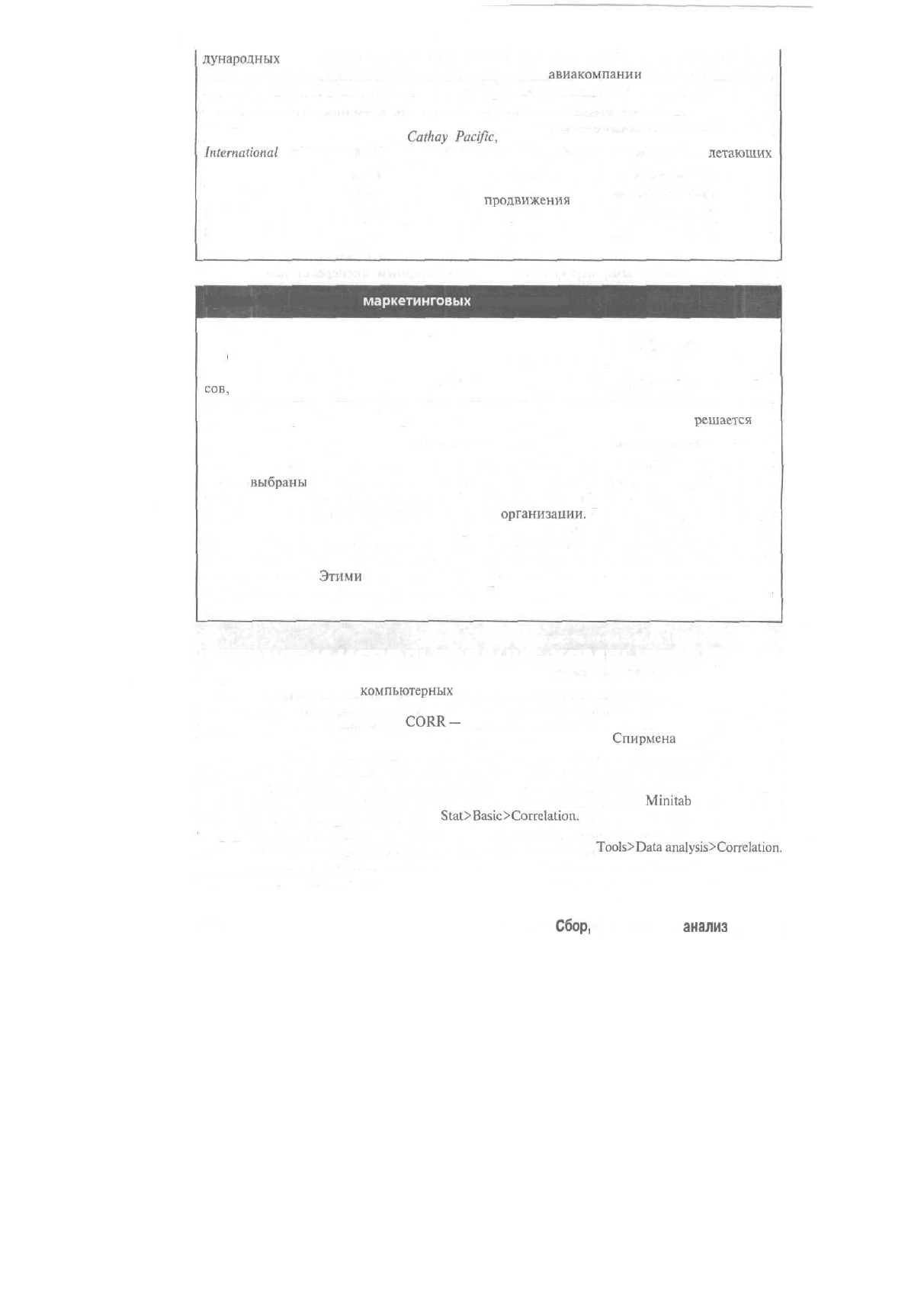
дународных
авиалиниях маркетологи применили множественный регрессионный анализ.
Вероятность полета и показатели выбора пассажирами
авиакомпании
служили зависимой
переменной, а набор сервисных факторов, включая программу для часто летающих пасса-
жиров, были независимыми переменными. В результате маркетологи обнаружили, что,
программа для часто летающих пассажиров влияла на выбор авиалинии. Исходя из этих
исследований, авиакомпании
Cathay
Pacific,
Singapore International Airlines, Thai Airways
International
и Malaysian Airline systems ввели совместную программу для часто
летающих
пассажиров под названием Asia Plus, доступную для всех пассажиров. Впервые в рамках
этой программы азиатские авиакомпании предлагали бесплатный полет для пассажиров,
регулярно пользующихся их услугами. Для
продвижения
программы Asia Plus компании
начали крупномасштабную маркетинговую и рекламную кампанию, в которую были
вложены миллионы долларов. Таким образом, у авиалиний Азии значительно увеличи-
лось число клиентов [34).
Врезка 17.2. Практика
маркетинговых
исследований
Этика и регрессионный анализ
С маркетинговыми исследованиями связано ряд этических проблем. В частности,
маркетологов, проводящих исследования, часто обвиняют в обмане, конфликте интере-
сов,
нарушении анонимности, вмешательстве в частную жизнь, фальсификации данных,
распространении ложных результатов исследования, а также в использовании его для
продажи товара. Было выдвинуто предположение, что когда исследователь
решается
на
неэтичный поступок, на это влияют разного рода организационные факторы, непосредст-
венно связанные с деятельностью его компании. Для их изучения было предпринято ис-
следование с применением множественного регрессионного анализа. В качестве незави-
симых
выбраны
шесть организационных переменных: наличие этических проблем внут-
ри организации; отношение к этим проблемам руководства компании; этический кодекс,
класс организации, категория отрасли и роль
организации.
Зависимой переменной слу-
жила оценка респондентами степени распространения неэтичной исследовательской
практики. В результате регрессионного анализа данных выявлено, что четыре из шести
переменных оказывали влияние на степень распространения неэтичной исследователь-
ской практикой.
Этими
переменными оказались: распространение этических проблем
внутри организации, отношение к этим проблемам руководства компании, роль органи-
зации и категория отрасли [35].
INTERNET И ИСПОЛЬЗОВАНИЕ КОМПЬЮТЕРА
Существует несколько
компьютерных
программ для выполнения корреляционного анали-
за. В программе SPSS можно использовать CORRELATIONS для вычисления коэффициента
корреляции Пирсона, PARTIAL
CORR—
для вычисления частных корреляций и NONPAR
CORR — для вычислений коэффициентов ранговой корреляции
Спирмена
р и Кендалла т.
В программе SAS можно использовать CORR для вычисления коэффициентов корреляций
Пирсона, Спирмена, Кендалла и коэффициентов частных корреляций. В BMDP с помощью
PSD вычисляют коэффициент корреляции Пирсона, с помощью P3S — коэффициенты корре-
ляции Спирмена и Кендалла, с помощью P6R — частные корреляции. В
Minitab
можно вычис-
лить корреляцию, используя функцию
Stat>Basic>Corre]ation.
С ее помощью вычисляют коэф-
фициент корреляции Пирсона.
В Excel для определения корреляции обращаются к функции
Tools>Data
analysis>Corre]ation.
Используйте функцию Correlation Worksheet Function, чтобы определить коэффициент корреля-
ции для двух рядов ячеек.
674
Часть III.
Сбор,
подготовка и
анализ
данных
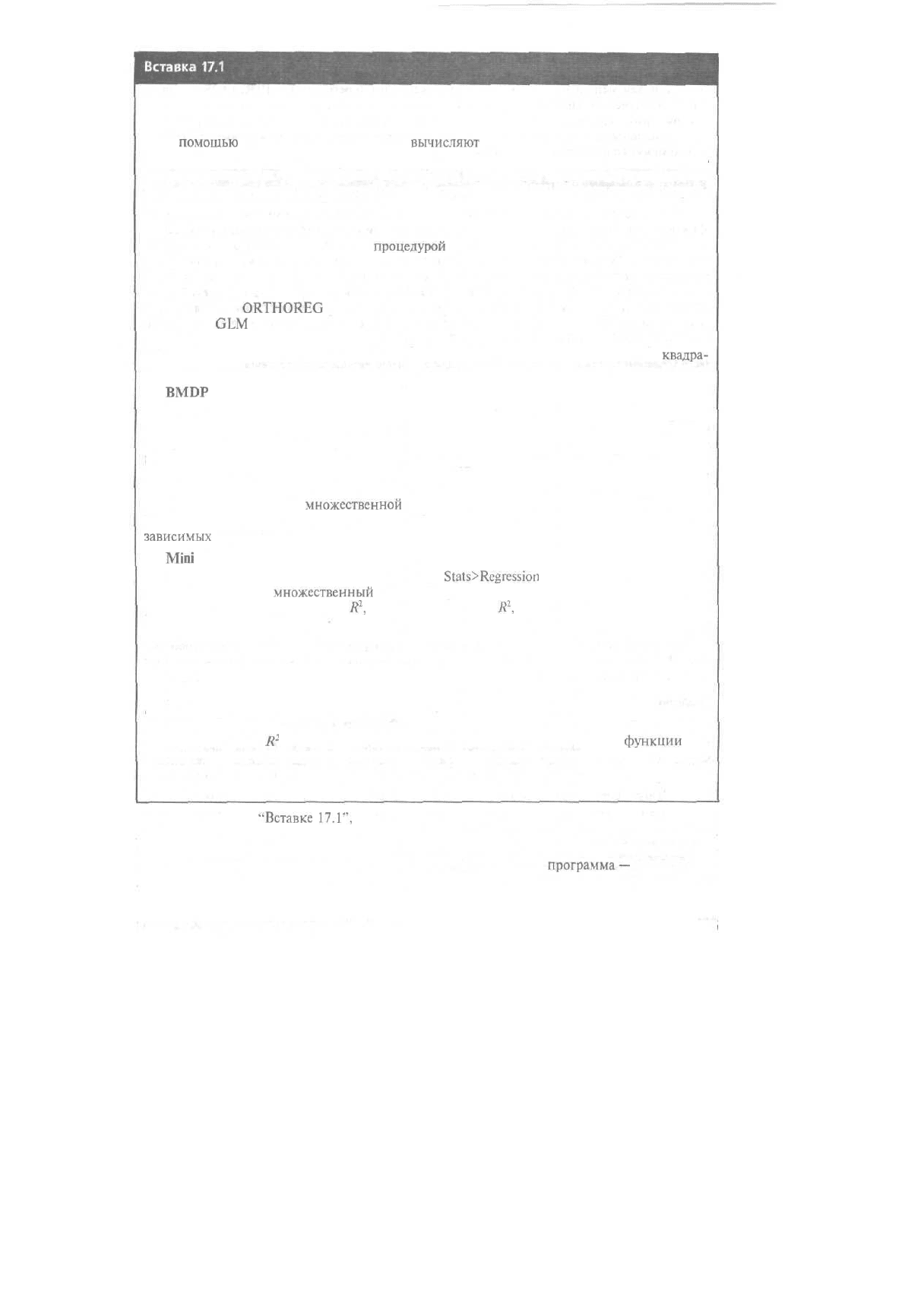
Компьютерные программы для анализа корреляции и регрессии
SPSS
С
помощью
программы REGRESSION
вычисляют
уравнения парной и множественной
регрессий, соответствующие статистики и графики. Она также позволяет легко проверить
значения остаточных членов. Можно выполнить и ступенчатую регрессию, Регрессионные
статистики также можно вычислить с помощью программы PLOT, которая строит диаграм-
мы рассеяния и другие виды диаграмм.
SAS
Программа REG является общей
процедурой
для выполнения регрессионного анализа,
которая подходит для парных и множественных регрессионных моделей при использовании
метода наименьших квадратов. Она позволяет вычислить все соответствующие статистики и
построить график расположения остаточных членов. Могут быть реализованы ступенчатые
методы. Метод
ORTHOREG
рекомендуют для регрессии в случае некорректных данных,
Программа
GLM
использует метод наименьших квадратов для подгонки общих линейных
моделей, ее также можно использовать для регрессионного анализа. С помощью программы
NLIN вычисляют параметры нелинейных моделей, используя методы наименьших
квадра-
тов или взвешенных наименьших квадратов.
BMDP
Программа P1R вычисляет парные и множественные линейные регрессии. Также можно
вычислить соответствующие статистики и построить диаграммы остаточных членов. P2R —
программа для вычисления ступенчатой регрессии с помощью разных подходов. Можно
предопределить порядок ввода или вывода переменных, определить ввод или вывод пере-
менных по частям, исходя из значения критерия. P9R выполняет все возможные подмноже-
ства регрессии. Эта программа идентифицирует "наилучшие" подмножества предикторов, ее
можно использовать для
множественной
регрессии без выбора подмножеств. Программа
P4R вычисляет регрессионный анализ по набору главных компонентов, полученных из не-
зависимых
переменных.
Mini
tab
Регрессионный анализ с помощью функции
Stats>Regression
может выполнять простой,
полиномиальный и
множественный
анализ. Результат включает линейное уравнение рег-
рессии, таблицу коэффициентов
R
2
,
скорректированный
Л
2
,
таблицу ANOVA, таблицу соот-
ветствий и остатков, которые дали необычные наблюдения. Другие доступные характери-
стики включают: ступенчатую регрессию, наилучшие подмножества, график подогнанной
линии регрессии и диаграммы остатков.
Excel
Регрессию можно вычислить с помощью меню Tools>Data analysis. В зависимости от вы-
бранных характеристик можно получить таблицу выходных данных, включая таблицу
ANOVA, стандартной ошибки у, коэффициенты регрессии, стандартную ошибку коэффи-
циентов, значения
Л-'
и количество наблюдений. Также с помощью данной
функции
вы-
числяют таблицу выходных данных остаточных членов, строят график остатков, аппрокси-
мированную прямую линейной зависимости, график нормального распределения вероятно-
сти и таблицу выходных данных, состоящую из двух колонок значений вероятностей.
Как описано во
"Вставке
17.1",
компьютерные программы содержат несколько программ
для выполнения регрессионного анализа, вычисления соответствующих статистик, выпол-
нения проверок значимости и построения графиков остаточных членов. В SPSS главная про-
грамма— REGRESSION. В SAS наиболее часто используемая
программа—
REG. Также
доступны и другие специализированные программы, такие как RSREG, ORTHOREG, GLM
Глава 17. Корреляция и регрессия 675
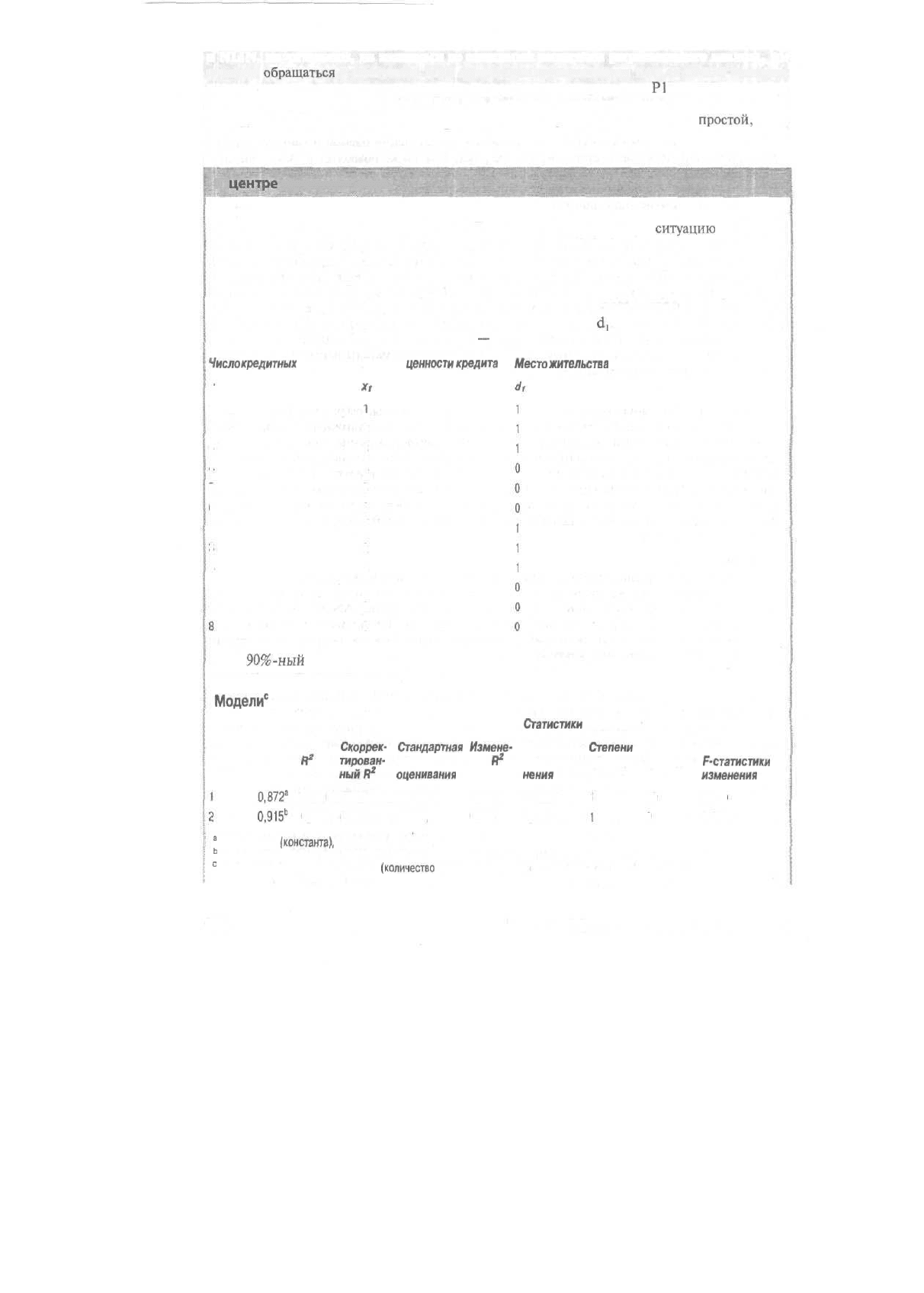
и NLIN, но читателям, не знакомым со сложными аспектами регрессионного анализа, мы
советуем
обращаться
к программе REG только при использовании SAS. В BMDP основная
программа для выполнения двумерной и множественной регрессии —
PI
R, a P2R — для сту-
пенчатой регрессии. Программы P9R и P4R более специализированные. В Minibab с помо-
щью функции Stats>Regression можно выполнить дисперсионный анализ, как
простой,
так и
полиномиальный и множественный. В Excel регрессионный анализ можно выполнить с по-
мощью меню Tools>Data analysis [36].
В
центре
внимания Burke
Мы часто сталкиваемся с ситуацией, когда одновременно необходимо анализировать
фиктивные и интервальные переменные. Проиллюстрируем подобную
ситуацию
на приме-
ре маркетингового исследования, проведенного компанией Burke, но с упрощенным набо-
ром данных. Респондентам был задан вопрос, сколько они имели в своем распоряжении
кредитных карточек на момент интервью и попросили проранжировать "ценность кредита"
по отношению к их образу жизни (по шкале рангов, начинающейся с предметов, крайне не-
обходимых для поддержания их образа жизни, и до предметов, необязательных для поддер-
жания принятого ими образа жизни). Фиктивная переменная
d,
указывает место жительства
респондентов: 1 — в сельской местности, 0
-—
в городе.
Число
кредитных
карточек
У
2
4
6
4
ь
6
2
3
4
5
6
Рейтинг
ценности
кредита
XI
'
2
3
4
5
6
1
2
3
4
5
6
Место
жительства
респондента
Построена регрессионная модель и в качестве критерия для включения переменной вы-
бран
90%-ный
доверительный уровень. Отдельные результаты множественного регрессион-
ного анализа приведены ниже.
Модели
0
Статистики
изменения
Модель R
Скоррек-
Стандартная
Измене-
F-сгатис-
Степени
Степени Значимость
тирован-
ошибка me
ft
2
тика изме- свободы свободы
F-статистики
оценивания
нения
1 2
изменения
0,872
Э
0,915
Ь
0,761
0,837
ныйй*
0,737
0,800
0,9131
07964,
0,761
0,075
31,876
4,146
I
10
9
0,000
0,072
3
Предикторы:
(константа),
ЦЕННОСТЬ КРЕДИТА
в
Предикторы: (константа), ЦЕННОСТЬ КРЕДИТА, МЕСТО ЖИТЕЛЬСТВА
с
Зависимая переменная: КАРТОЧКИ
(количество
кредитных карточек)
676
Часть III. Сбор, подготовка и анализ данных
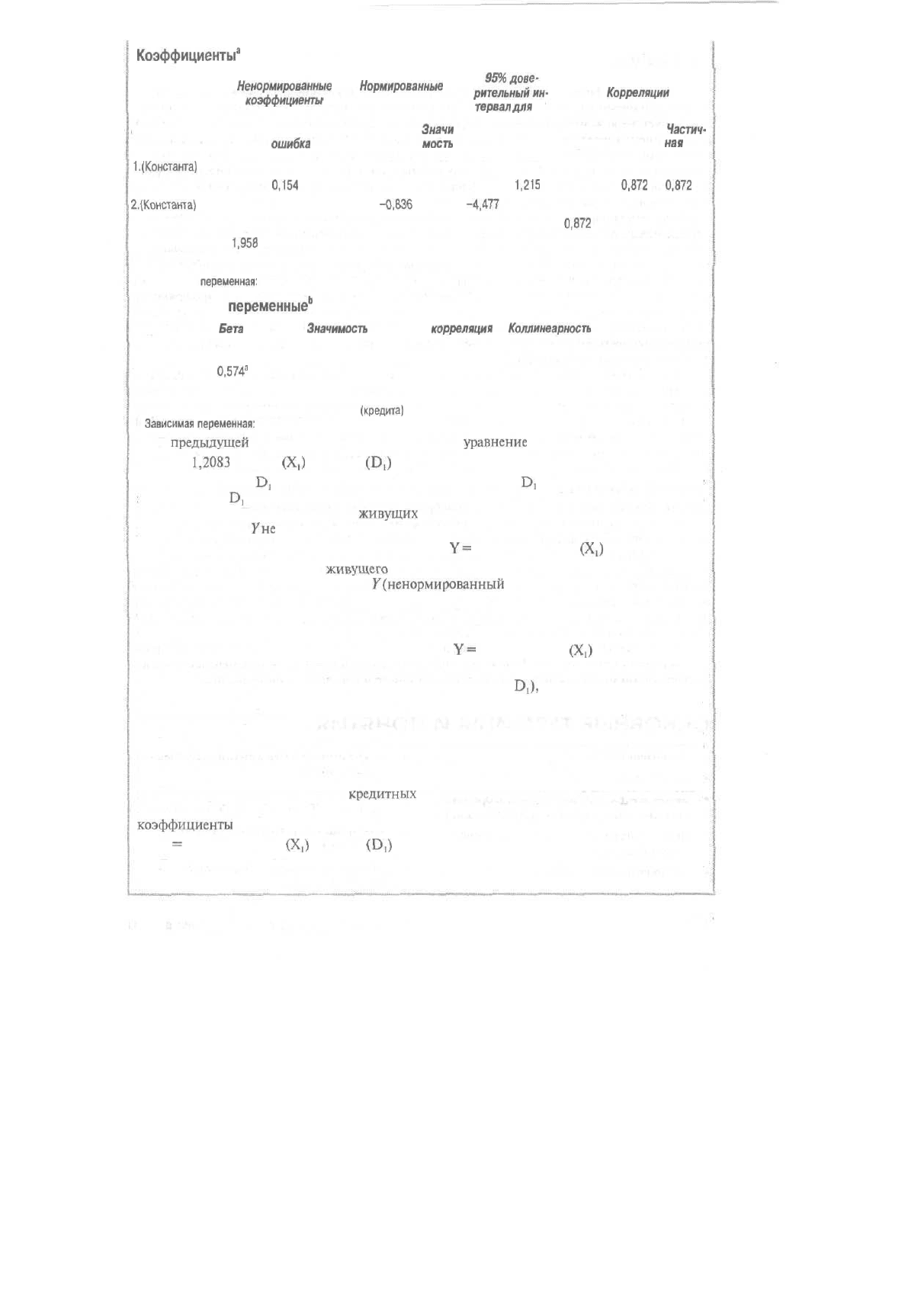
Коэффициенты
3
Недатированные
Нормированные
р
?™*°£
т
.
Корреляции
коэффициенты
коэффициенты
гервал
для
В
Модель В Стандартная ft t
Значи
Нижний Верхний Нулевого Част-
Частич-
ошибка
мость
порядок ная
пая
1.(Констанга)
1,533 0,601 2,551 0,029 0,194 2,873
ЦЕННОСТЬ 0,871
0,154
0,872 5,646 0,000 0,528
1,215
0,872
0,872 0,872
2.(КонСтанта)
-1,208 1,445
-0,836
0,425
-4,477
2,060
ЦЕННОСТЬ 1,375 0,282 1,377 4,883 0,001 0,738 2,012
0,872
0,852 0,658
МЕСТО
1,958
0,962 0,574 2,036 0,072 -0,217 4,134 -0,635 0,562 0,274
ЖИТЕЛЬСТВА
а. Зависимая
переменная:
КАРТОЧКИ (количество кредитных карточек)
Исключенные
переменные"
Модель
Бега
t
Значимость
Частная
корреляция
Коллинеарность
Допустимое отклонение статистик
1 МЕСТО
0,574
а
2,036 0,072 0,562 0,229
ЖИТЕЛЬСТВА
а Предикторы в модели: (Константа]. ЦЕННОСТЬ
(кредита)
b
Зависимая
переменная:
КАРТОЧКИ (количество кредитных карточек)
В
предыдущей
модели мы определили следующее
уравнение
регрессии:
Y= -
1,2083
+ 1,375
(X,)
+ 1,9583
(D,)
Вспомните, что
D;
— просто или нуль, или 1, причем если
D[
= 0, то респонденты живут
в городе. Если
D,
= 1, то респонденты живут в сельской местности. Можно описать модель
как две модели. Для респондентов,
живущих
в городе, получим следующее уравнение рег-
рессии, в котором
Кне
зависит от фиктивной переменной — кода местности.
Городская модель
Y=
- 1,2083 + 1,375
(X,)
Для каждого респондента,
живущего
в сельской местности, вклад переменной — место
жительства в зависимую переменную
Y(ненормированный
коэффициент) равен 1,9583. По-
этому для таких респондентов это постоянное значение, и мы может добавить его к констан-
те общей модели (например, — 1,2083 + 1,9583 = 0,75). Теперь мы имеем отдельную регрес-
сионную модель для респондентов, живущих в сельской местности.
Сельская модель
Y=
0,7500 + 1,375
(Xj)
Это единственный способ увидеть различие между этими двумя постоянными членами
(различие состоит, конечно, в коэффициенте регрессии для
DJ),
который отражает среднее
различие между городскими и сельскими респондентами при постоянном значении рей-
тинга ценности кредита.
Как все это применить на практике? Создавая модели с фиктивной переменной, как бы-
ло проиллюстрировано, мы допускали, что зависимость количества кредитных карточек от
рейтинга ценности кредита является постоянной, т.е. не зависит от того, живут респонденты
в городе или в сельской местности. Это можно проверить, установив связь между рейтингом
ценности кредита и количеством
кредитных
карточек в зависимости от типа респондента.
Затем можно проверить две модели с разными угловыми коэффициентами. Если угловые
коэффициенты
не отличаются, то можно использовать одну общую модель:
Y
-
- 1,2083 + 1,375
(X,)
+ 1,9583
(D,)
Если угловые коэффициенты разные, то следует построить различные модели для рес-
пондентов из города и сельской местности.
Глава 17. Корреляция и регрессия 677
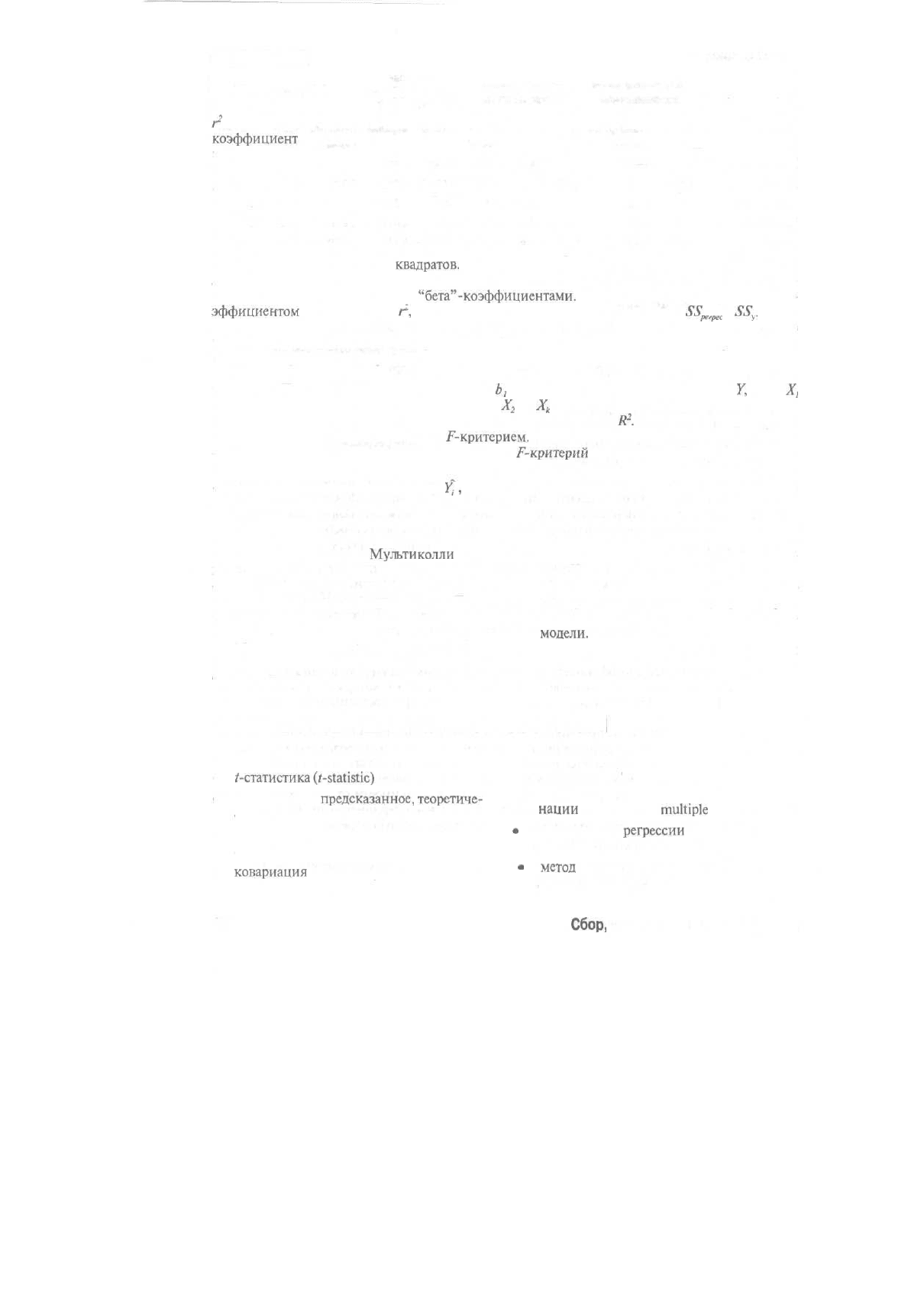
РЕЗЮМЕ
Парный коэффициент корреляции г является мерой линейной связи между двумя метри-
ческими (измеренными интервальной или относительной шкалой) переменными. Его квадрат
г
2
измеряет долю вариации одной из переменных, обусловленную вариацией другой. Частный
коэффициент
корреляции — мера зависимости между двумя переменными после исключения
эффекта от влияния одной или нескольких дополнительных переменных. Порядок частной
корреляции указывает на количество переменных, на которые необходимо внести поправку
или которые следует исключить. Коэффициенты частной корреляции могут оказаться полез-
ными для выявления ложных связей.
С помощью парной регрессии устанавливается математическая зависимость (в виде урав-
нения) между метрической зависимой (критериальной) переменной и метрической независи-
мой переменной (предиктором). Уравнение описывает прямую линиию, и для его вывода ис-
пользуют метод наименьших
квадратов.
В случае построения регрессии с нормированными
данными отрезок, отсекаемый на оси OY, принимает значение, равное 0, и коэффициенты рег-
рессии называют взвешенными
"бета"-коэффициентами.
Силу тесноты связи измеряют ко-
эффициентом
детерминации
г,
который получают, вычисляя отношение
SS
peefW
к
SS
r
Стан-
дартную ошибку уравнения регрессии используют для оценки точности предсказания, и ее
можно интерпретировать как род средней ошибки, сделанной при теоретическом предсказании
Y, исходя из уравнения регрессии.
Множественная регрессия включает одну зависимую и две (или больше) независимых пе-
ременных. Частный коэффициент регрессии
Ь,
представляет ожидаемое изменение
Y,
когда
X,
меняется на одну единицу, а переменные от
Х
2
до
X
k
остаются постоянными. Силу тесноты
связи измеряют коэффициентом множественной детерминации
R
2
.
Значимость общего урав-
нения регрессии проверяется общим
F-критерием.
Отдельные частные коэффициенты регрес-
сии можно проверить на значимость, используя
F-критерий
приращений. Диаграммы рассея-
ния остаточных членов, когда их значения представлены графически в зависимости от пред-
сказанных теоретических значений
К
;
,
времени или предикторов, полезны для проверки
соответствия основным допущениям и подобранной регрессионной модели.
При пошаговой регрессии предикторы вводят или выводят из уравнения регрессии один за
другим с целью выбора меньшего их числа, которые объясняют большую часть вариации кри-
териальной переменной.
Мул
ьти
колли
неарность или очень высокая взаимная корреляция ме-
жду предикторами может вызвать некоторые проблемы. Из-за того, что предикторы взаимо-
связаны (коррелируют), регрессионный анализ не обеспечивает однозначного свидетельства об
относительной важности предикторов. Перекрестная проверка может установить, верна ли рег-
рессионная модель для сопоставимых данных, не использованных при ее вычислении. Она яв-
ляется полезным методом при оценке регрессионной
модели.
Можно использовать категориальные переменные как предикторы путем их кодирования
как фиктивных переменных. Множественная регрессия с фиктивными переменными предос-
тавляет общий метод для выполнения дисперсионного и ковариационного анализа.
ОСНОВНЫЕ ТЕРМИНЫ И ПОНЯТИЯ
• F-критерий (F-test) • коэффициент детерминации (coefficient of
•
^-статистика
(/-statistic)
determination)
• вычисленное,
предсказанное,
теоретиче-
* коэффициент множественной детерми-
ское значение (estimated, predicted value)
нации
(coefficient
of
multiple
determination)
• двойная перекрестная проверка (double
*
коэффициент
регрессии
(regression
cross-validation) coefficient)
•
ковариация
(covariance)
*
метод
наименьших квадратов (least-
squares procedure)
678 Часть III.
Сбор,
подготовка и анализ данных
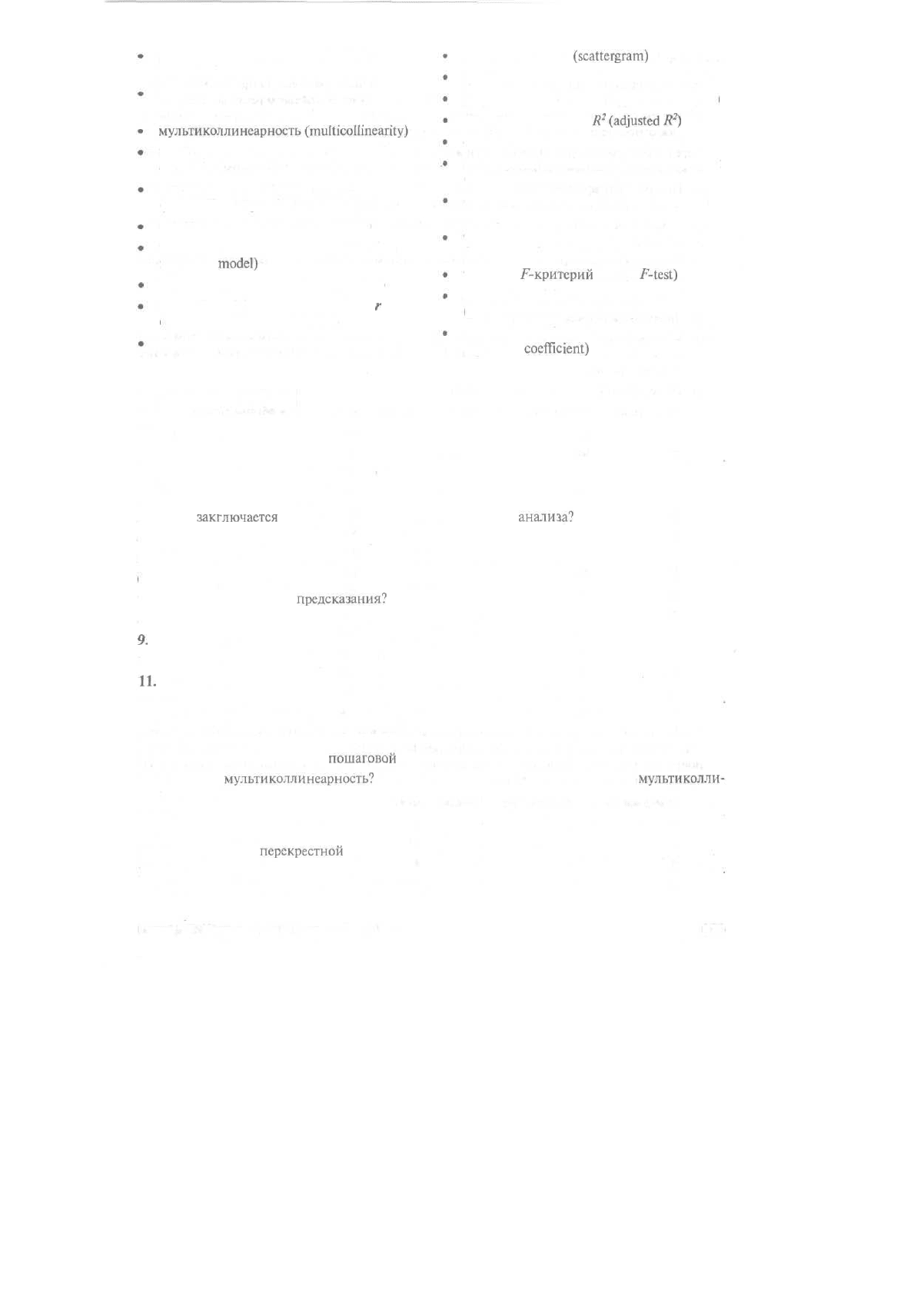
множественная регрессия (multiple
regression)
модель множественной регрессии
(multiple regression model)
мудьтиколлинеарность(тиШсоШпеапЧу)
неметрическая корреляция (nonmetric
correlation)
нормированный коэффициент регрессии
(standardized regression coefficient)
остаточный член, остаток (residual)
парная регрессионная модель (bivariate
regression
model)
парная регрессия (bivariate regression)
парный коэффициент корреляции
г
(product moment correlation, r)
перекрестная проверка (cross-validation)
поле корреляции
(scattergram)
пошаговая регрессия (stepwise regression)
регрессионный анализ (regression analysis)
скорректированный
/^(adjusted
R
2
)
стандартная ошибка (standard error)
стандартная ошибка уравнения регрессии
(standard error of estimate)
сумма квадратов ошибок (sum of squared
errors)
частичный коэффициент корреляции
(part correlation coefficient)
частный
F-критерий
(partial
f-test)
частный коэффициент корреляции
(partial correlation coefficient)
частный коэффициент регрессии (partial
regression
coefficient)
УПРАЖНЕНИЯ
Вопросы
1. Что такое парный коэффициент корреляции? Указывает ли его значение, равное 0, что пе-
ременные не связаны между собой?
2. Что такое частный коэффициент корреляции?
3. В чем
закглючается
основное применение регрессионного
анализа?
4. Что такое метод наименьших квадратов?
5. Объясните значение нормированных коэффициентов регрессии.
6. Как измеряют тесноту связи при парной регрессии? А при множественной?
7. Что означает точность
предсказания?
8. Что такое стандартная ошибка уравнения регрессии?
9.
Какие допущения лежат в основе парной регрессии?
10. Что такое множественная регрессия?
11.
Объясните, что такое частный коэффициент регрессии. Почему он так назван?
12. Сформулируйте нулевую гипотезу при проверке значимости общего уравнения множест-
венной регрессии. Как проверяют данную нулевую гипотезу?
13. Для чего нужен анализ остаточных членов?
14. Объясните, что такое метод
пошаговой
регрессии. Какова его цель?
15. Что такое
мультиколлинеарность?
Какие проблемы могут возникнуть из-за
мультиколли-
неарности?
16. Какие показатели используют для оценки относительной важности предикторов при мно-
жественной регрессии?
17. Опишите метод
перекрестной
проверки. Опишите метод двойной перекрестной проверки.
18. Продемонстрируйте эквивалентность регрессии с фиктивными переменными и однофак-
торного дисперсионного анализа (ANOVA).
Глава 17. Корреляция и регрессия
679
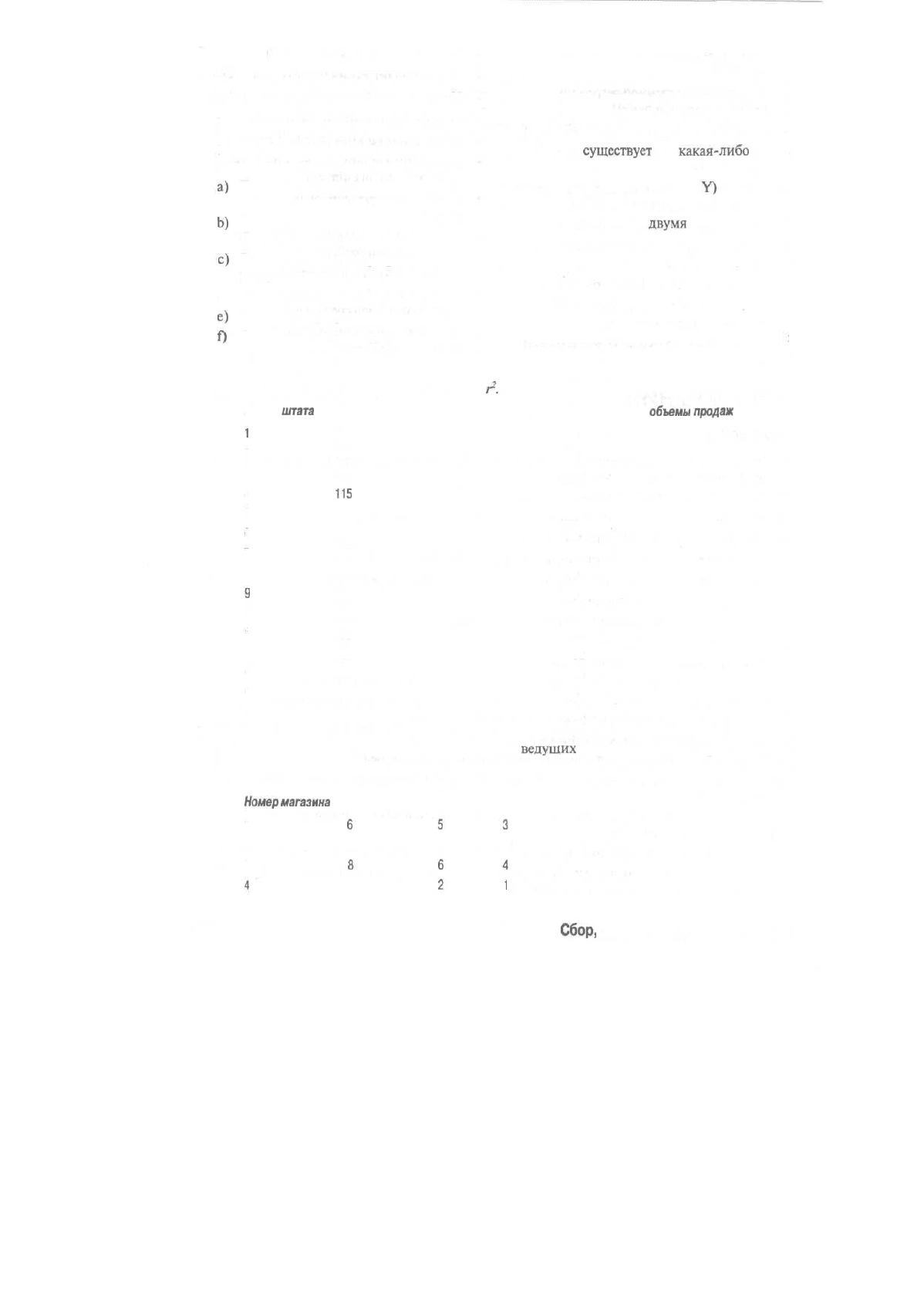
Задачи
1. Руководство сети универмагов хочет определить, как влияют расходы на продвижение това-
ров, на конкурентоспособность сети. Из 15 штатов получены данные о расходах на продви-
жение относительно главного конкурента (расходы конкурента приняли за 100) и об объеме
продаж относительно этого же конкурента (объем продаж конкурента принят за 100).
Перед вами поставлена задача — доложить руководству,
существует
ли
какая-либо
связь
между относительными затратами на продвижение и относительным объемом продаж.
a)
Постройте график зависимости относительных объемов продаж (по оси
Y)
от относи-
тельных расходов на продвижение (ось X) и поясните полученный график.
b)
Какой показатель использовать для установления связи между
двумя
переменными?
Почему?
c)
Выполните парный регрессионный анализ объемов продаж от относительных расходов
на продвижение.
d) Поясните коэффициенты регрессии.
e)
Значима ли регрессионная связь?
f)
Если наша сеть имеет одинаковые расходы на продвижение со своим конкурентом (если
относительные расходы на продвижение составили 100), то какими должны быть у нее
объемы продаж?
g) Интерпретируйте полученное значение
г
2
.
Номер
штата
Относительные расходы на продвижение Относительные
объемы
продаж
1
95 98
2 92 94
3 103 110
4
115
125
5 77 82
6 79 84
7 105 112
8 94 99
3
85 93
10 101 107
И 106 114
12 120 132
13 118 129
14 75 79
15 99 105
2. Чтобы понять роль влияния качества и цены товаров на количество постоянных посетите-
лей магазинов, маркетологи собрали оценки 14
ведущих
магазинов с точки зрения: пред-
почтения магазина, качества товара и приемлемости иен. Магазины оценивали по 11-
балльной шкале, — чем больше балл, тем выше оценка.
Номер
магазина
Предпочтение Качество Цена
1
653
2 9 6 11
3
864
3
21
680 Часть III.
Сбор,
подготовка и анализ данных
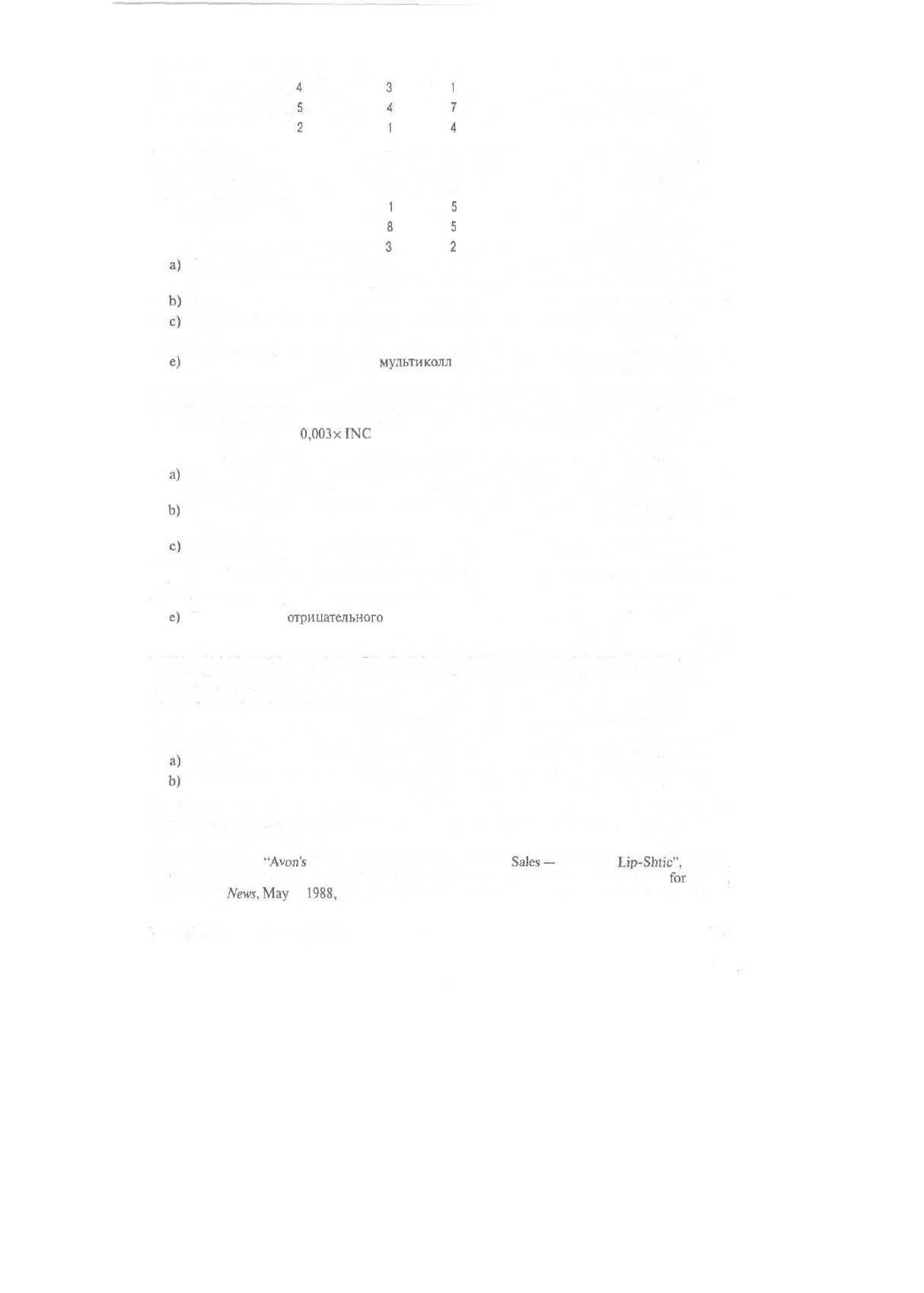
5 10 6 11
6
431
7
547
8
214
9 11 9 8
10 9 5 10
11 10 8 8
12 2
15
13 9
85
14 5
32
a)
Выполните множественный регрессионный анализ, объясняющий предпочтения в от-
ношении магазинов с точки зрения качества товара и цены.
b)
Объясните частные коэффициенты регрессии.
c)
Определите значимость всей регрессии.
d) Определите значимость частных коэффициентов регрессии.
e)
Как вы считаете, является ли
мул
ьтиколл
и неарность проблемой в данном случае? По-
чему да или почему нет?
3. Вы прочли в журнале статью, в которой говорится, что между ежегодными затратами на го-
товые обеды (PD) и годовым доходом (1NC) существует следующая связь:
PD = 23,4 +
0,003
xINC
Коэффициент при переменной INC считается значимым.
a)
Правдоподобна ли эта связь? Может ли коэффициент регрессии, небольшой по вели-
чине, быть значимым?
b)
Можете ли вы, исходя из предоставленной информации, сказать, хорошо ли разработа-
на модель?
c)
Чему равны ожидаемые затраты на готовые обеды для семьи, зарабатывающей 30 тысяч
долларов в год?
d) Если семья, зарабатывающая 40 тысяч долларов в год, тратит 130 долларов на готовые
обеды, то чему равен остаточный член?
e)
В чем значение
отрицательного
остаточного члена?
УПРАЖНЕНИЯ С ИСПОЛЬЗОВАНИЕМ INTERNET
И КОМПЬЮТЕРА
1. Используйте соответствующие компьютерные программы (SPSS, SAS, BMDP, Minitab или
Excel) для анализа данных из;
a)
задачи 1
b)
задачи 2.
КОММЕНТАРИИ
1. Jennifer Zajac,
"Avon's
Finally Glowing Thanks to Global
Sales—
and New
Lip-Shtic",
Money,
September 1997, p. 60; Cyndee Miller, "Computer Modelling Rings the Right Bell
for
Avon",
Marketing
News,
May
9,
1988,
p. 14.
Глава 17. Корреляция и регрессия 681
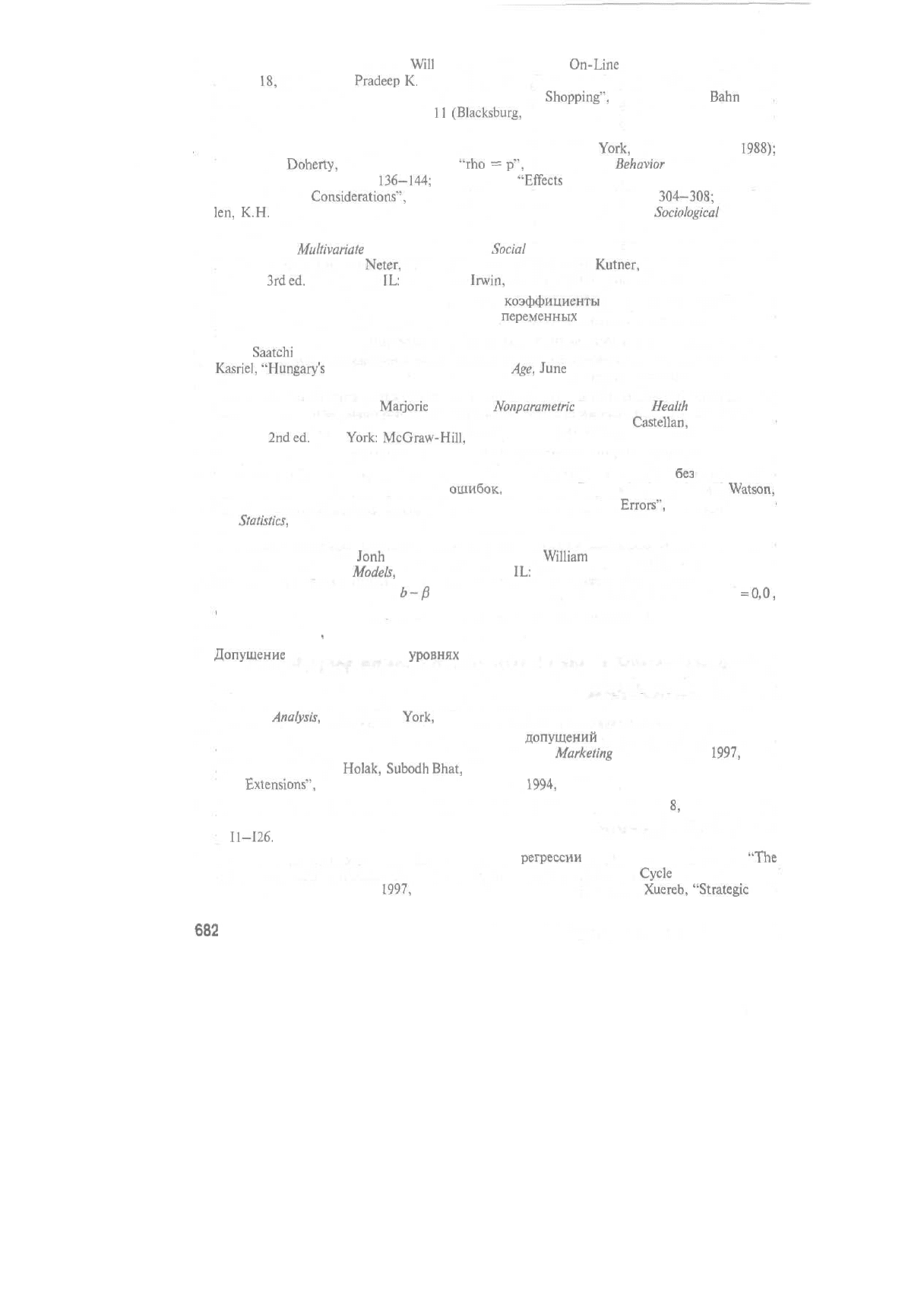
2. Lauren Freedman, "Brand Names
Will
Bring New Velocity to
Qn-Line
Sales", Discount Store News,
August
18,
1997, p, 12;
Pradeep
K.
Korgaonkar, Allen E, Smith, "Shopping Orientation, Demo-
graphic and Media Preference Correlates of Electronic
Shopping'
1
,
in Kenneth D.
Bahn
(ed.),
Development in Marketing Science, vol.
11
(Blacksburg,
VA: Academy of Marketing Science, 1988),
p.
52-5.
3. N.R. Draper, H. Smith, Applied Regression Analysis, 3rd ed. (New
York,
NY: John Wiley,
1988);
Michael E.
Doherty,
James A. Sullivan,
"rho
=
p".
Organisational
Behavior
& Human Decision
Processes, February 1989, p.
136—144;
W.S. Martin,
"Effects
of Scaling on the Correlation Coeffi-
cient: Additional
Considerations",
Journal of Marketing Research, May 1978, p.
304—308;
K.A. Bo]-
len,
K.H.
Barb, "Pearson's R and Coarsely Categorized Measures", American
Sociological
Review 46
(1981), p. 232-239.
4. Jacques Tacq,
Multivariate
Analysis Techniques in
Social
Science Research (Thousand Oaks, CA: Sage
Publications, 1997); John
Neter,
William Wasserman, Michael J.
Kutner,
Applied Linear Statistical
Methods,
3rded.
(Burr Ridge,
IL:
Richard
D.
Irwin,
1990),
p.
501-503.
5. Хотя эта тема здесь и не обсуждается, частные
коэффициенты
корреляции могут оказаться
полезными при размещении промежуточных
переменных
и разработке определенных ти-
пов каузальных статистических выводов.
6. "Bates
Saatchi
& Saatchi, Budapest: Accounting for Change", Accountancy, August 1995, p. 31; Ken
Kasriel,
"Hungary's
Million-Dollar Slap", Advertising
Age,
June
8, 1992.
7. Другим преимуществом т является то, что его можно обобщить до частного коэффициента
корреляции. См. работы
Marjorie
A. Pett,
Nonparametric
Statistics for
Health
Care Research
(Thousand Oaks, CA: Sage Publications, 1997); Sidney Siegel, N.J.
Castellan,
Nonparametric
Statistics,
2nded.
(New
York:
McGraw-Hill,
1988).
8. В строгом смысле регрессионная модель требует, чтобы ошибки измерения были связаны
только с критериальной переменной и чтобы предикторы были измерены
без
ошибок. Что
касается сериально коррелированных
ошибок,
см. статью Eugene Canjels, Mark W.
Watson,
"Estimating Deterministic Trends in the Presence of Serially Correlated
Errors",
Review of Economics
and
Statistics,
May 1997, p. 184-200.
9. См. любую книгу по регрессии, например, N.R. Draper, H. Smith, Applied Regression Analysis,
3rd ed. (New York, NY:
Jonh
Wiley, 1998); John Neter,
William
Wasserman, Michael H. Kutner,
Applied Linear Regression
Models,
3rd ed. (Burr Ridge,
IL:
Richard D, Irwin, 1990).
10. Формально числитель равен
b-{3
. Однако, поскольку выдвинута гипотеза, что fi
=0,0,
его можно не включать в формулу.
П. Чем больше SEE
,
тем меньше подходит регрессия.
12.
Допущение
о фиксированных
уровнях
предикторов допускается в "классической" регрес-
сионной модели. Это возможно в случае соблюдения определенных условий, когда предик-
торы являются случайными переменными. Однако нельзя, чтобы их распределение зависе-
ло от параметров регрессионного уравнения. См. монографию N.R. Draper, H. Smith, Applied
Regression
Analysis,
3rd. ed. (New
York,
NY: John Wiley, 1998).
13. Относительно метода обработки нарушений таких
допущений
см. работы Gary S. Dispensa,
"Use Logistic Regression with Customer Satisfaction Data",
Marketing
News, January 6,
1997,
p. 13;
S.K. Reddy, Susan L.
Holak,
Subodh
Bhat,
"To Extend of Not to Extend: Success Determinants of
Line
Extensions",
Journal of Marketing Research, May
1994,
p. 243-262.
14. Jon
Rees, "Tight
Ship
Keeps Coke
on Top of the
World", Marketing
Week,
May
8,
1997,
p.
28-29;
Nancy Giges, "Europeans Buy Outside Goods, but Like Local Ads", Advertising Age, April 27, 1992,
p. 11-126.
15. Относительно других применений множественной
регрессии
см. работы Abbie Griffin,
"The
Effect of Project and Process Characteristics on Product Development
Cycle
Time", Journal of
Marketing Research, February
1997,
p.
24-35;
Hubert
Gatignon,
Jean-Mark
Xuereb,
"Strategic
Ori-
662
Часть III. Сбор, подготовка и анализ данных
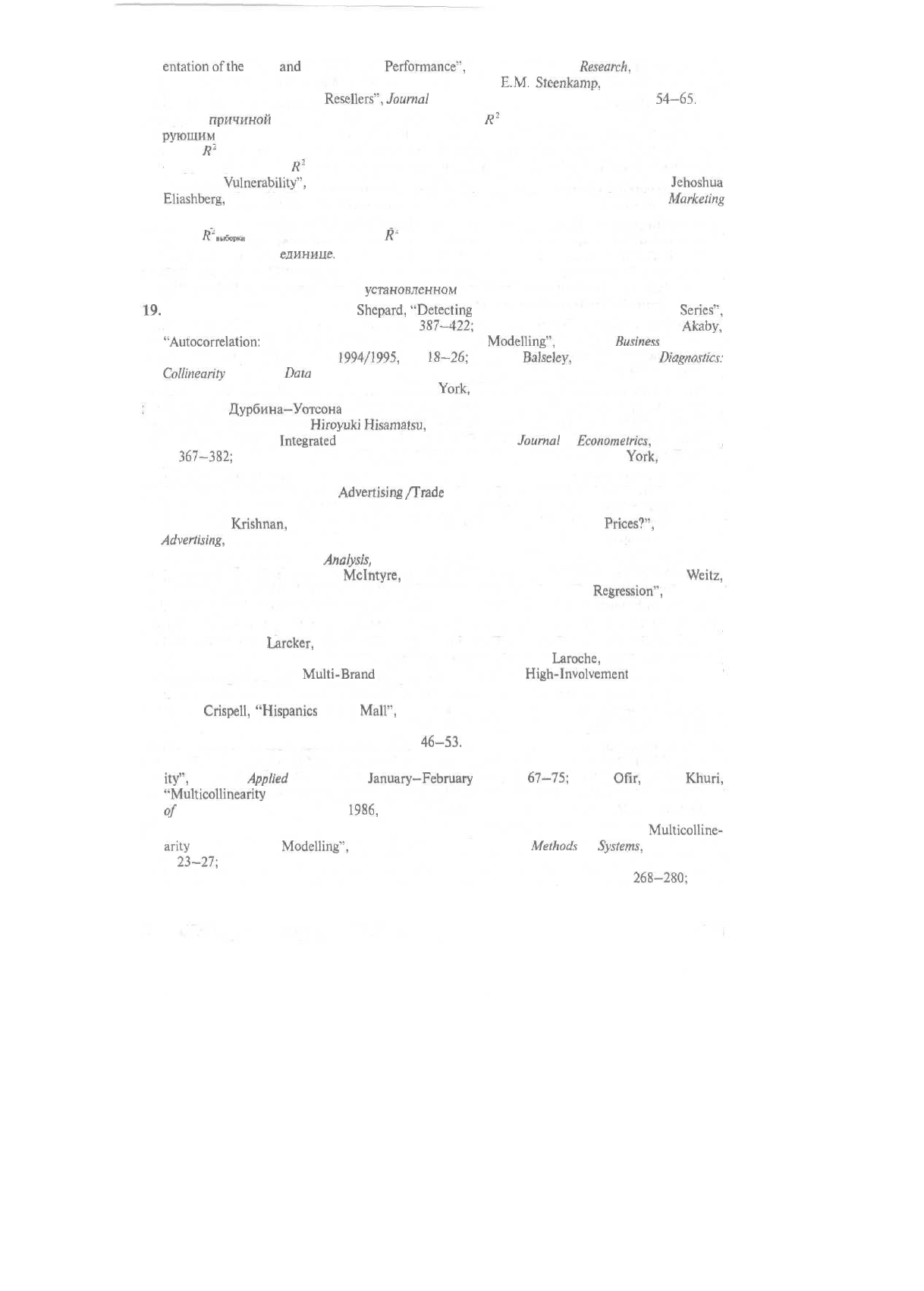
entationofthe
Firm
and
New Product
Performance
71
,
Journal of Marketing
Research,
February 1997,
p. 77-90; Nirmalya Kumar, Lisa K. Scheer, Jan-Benedict
E.M.
Steenkamp,
"The Effects of Sup-
plier Fairness on Vulnerable
Resellers",
Journal
of Marketing Research, February 1995, p,
54—65.
16. Другой
причиной
применения скорректированного
R
2
служит то, что благодаря оптимизи-
рующим
свойствам метод наименьших квадратов максимален. Поэтому до некоторой сте-
пени
R-
всегда переоценивает величину связи. Относительно современного применения
скорректированного
R
2
см. работы "Ethics and Target Marketing: The Role of Product Harm and
Consumer
Vulnerability",
Journal of Marketing, January 1997, p. 1-20; Morris A. Cohen,
Jehoshua
Eliashberg,
Teck H. Ho, "An Anatomy and Launching Line Extensions", Journal of
Marketing
Research, February 1997, p. 117-129.
17.
Если
ЙЧыборт
равен
0, то
обычный
R~
отражает
только
ошибку выборки
и F
коэффициент
будет стремиться к
единице.
18. Другим подходом является иерархический метод, при котором переменные добавляют к
уравнению регрессии в порядке,
установленном
исследователем.
19.
А.С. Atkinson, S.J. Koopman, N.
Shepard,
"Detecting
Shocks: Outliers and Breaks in Time
Series",
Journal of Econometrics, October 1997, p.
387—422;
George C.S. Wang, Charles K.
Akaby,
"Autocorrelation:
Problems and Solutions in Regression
Modelling",
Journal of
Business
Forecasting
Methods & Systems, Winter
1994/1995,
p.
18—26;
David
Balseley,
Conditioning
Diagnostics:
Collinearity
and Weak
Data
in Regression (New York, NY: John Wiley, 1980); David Balseley, Edwin
Kuh, Roy E. Walsh, Regression Diagnostics (New
York,
NY: John Wiley, 1980).
20. Критерий
Дурбина—Уотсона
обсуждается практически в каждом учебнике по регрессии.
См., например, работы:
Hiroyuki
Hisamatsu,
Koichi Maekawa, "The Distribution of the Durbin—
Watson Statistic in
Integrated
and Near-Integrated Models",
Journal
of
Econometrics,
April 1994,
p.
367—382;
N.R. Draper, H. Smith, Applied Regression Analysis, 3rd ed. (New
York,
NY: John
Wiley, 1998).
21. Helen Berman, "Selling the
Advertising
Дгж1е
Show Partnership", Folio: The Magazine for
Magazine Management (Special Sourcebook Issue for 1997 Supplement), p. 214-215; Lawrence
Sotey, R.
Krishnan,
"Does Advertising Subsidize Consumer Magazine
Prices?",
Journal of
Advertising,
Spring 1987, p. 4-9.
22. John Fox, Applied Regression
Analysis,
Linear Models and Related Methods (Thousand Oaks, CA: Sage
Publications, 1997); Shelby H,
Mclntyre,
David B. Montgomery, V. Srinivasan, Barton A.
Weitz,
"Evaluating the Statistical Significance of Models Developed by Stepwise
Regression",
Journal of
Marketing Research, February 1983, p. 1-11,
23. Относительно современного применения ступенчатой регрессии см. работы Christopher D.
Ittner, David F.
Larcker,
"Product Development Cycle Time and Organisational Performance",
Journal of Marketing Research, February 1997, p. 13-23; Michael
Laroche,
Robert Sadokierski,
"Role of Confidence in a
Multi-Brand
Model of Intentions for a
High-Involvement
Service", Journal
of Business Research, January 1994, p. 1-12.
24. Diane
Crispell,
"Hispanics
at the
Mall",
American Demographics, October 1997, p, 35-36; Glen R.
Jarboe, Carl D. McDaniel, "A Profile of Browsers in Regional Shopping Malls", Journal of the
Academy of Marketing Science, Spring 1987, p.
46—53.
25. Edward Greenberg, Robert Parks, "A Predictive Approach to Model Selection and Multicollinear-
ity",
Journal of
Applied
Econometrics,
January-February
1997, p.
67—75;
Chezy
Ofir,
Andre
Khuri,
"Multicollinearity
in Marketing Models: Diagnostics and Remedial Measures", International Journal
of
Research in Marketing, March
1986,
p. 181-205.
26. Возможные процедуры приведены в работах George C.S. Wang, "How to Handle
MuHicolline-
arity
in Regression
Modelling",
Journal of Business Forecasting
Methods
&
Systems,
Spring 1996,
p.
23—27;
Charlotte H. Mason, William D. Perreault, Jr., "Collinearity, Power, and Interpretation of
Multiple Regression Analysis", Journal of Marketing Research, August 1991, p.
268-280;
R.R.
Глава 17, Корреляция и регрессия 683
